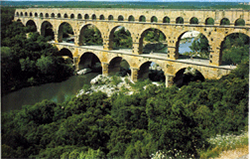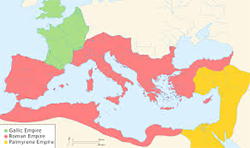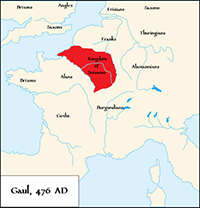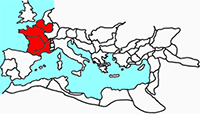The Gauls
Part 4: From Rome to the Franks Rome's first emperor, Augustus, divided Gaul into four provinces:

Roman Gaul began to resemble other lands conquered by Rome: Amphitheaters, aqueducts, baths, and temples dotted the landscape of the various Gallic main centers. Also built during this time were a great many stone houses, a departure from the temporary wooden houses in which the Gauls had lived for so long. Helping keep the peace were Roman veterans of the war with Gaul, given land as gift for fighting. With the exception of a couple minor rebellions–one in 21 and another in 69–the Gallic people chose to flourish under Roman rule rather than to continually contest it. The two cultures merged more and more, the Gauls switching from the Greek alphabet to the Roman alphabet being a sign of a fundamental shift to the new way of life. As well, the Druidic tradition that the Gauls counted from their earliest days as Celts was just another element of their previous life to be replaced, first by the Roman religious tradition and then by Christianity. One significant addition to Roman culture by the Gauls was the barrel. By and large, the warmth of the Mediterranean climate precluded the growth of oak trees. Further north, however, in Gaul, grew oak trees, from which Gauls made oak barrels, for transporting food and drink. The Gauls generally preferred beer and ale, but the combined Gallo-Roman culture soon used oak barrels to store and transport wine as well. In time, the Romans abandoned the amphora as a wine storage device. 
For nearly two centuries, the Romans under Augustus and then a series of emperors enjoyed the Pax Romana, or "Roman Peace." The Roman military commander and Germania governor Marcus Cassianius Latinius Postumus took over Gaul (along with Brittania and Hispania) in 260. He kept hold of it for nearly a decade, until a Roman army under the emperor Aurelian conquered the usurper and brought Gaul back into the Roman fold. Near the end of the 2nd Century, more invaders appeared from the north and east. Raiding Gaul and Italy were the Alemanni. Other invaders included the Burgundians and Franks. Rome by this time was beset seemingly on all sides by wave after wave of invaders. The Vandals ravaged Gaul in 406. Four years later came the Visigoths, on their way to sack Rome. A still reeling Gaul had to contend with Attila and the Huns a few decades after that. 
In 457, the Roman emperor Majorian appointed Aegidius as the ruler of Roman Gaul. Aegidius survived the growing chaos in Rome itself, ruling essentially on his known a collection of lands known as the Domain of Soissons. Aegidius died within a decade of assuming the leadership of this land, and his son Syagrius succeeded him. In 486, the Franks, under King Clovis I, defeated Syagrius and assumed control of his territory, thereby bringing most of Gaul under the rule of what would become the Merovingian dynasty. First page > Gallic traditions > Page 1, 2, 3, 4 |
|
Social Studies for Kids
copyright 2002–2026
David White



 Belgica, in the northeast
Belgica, in the northeast
